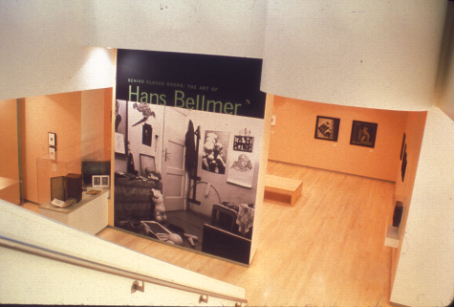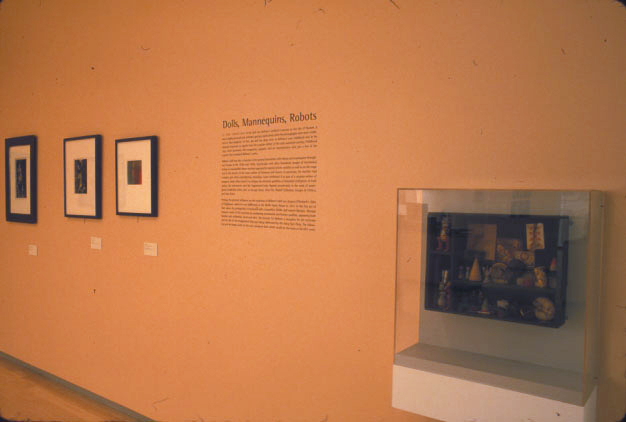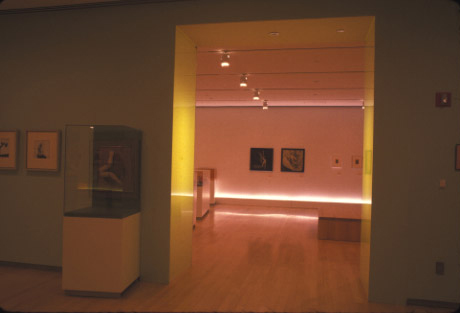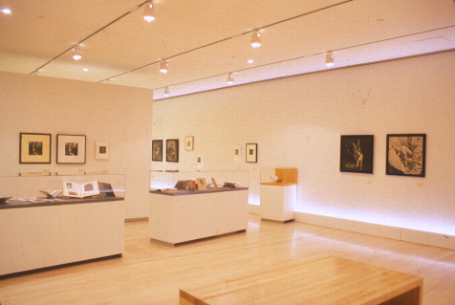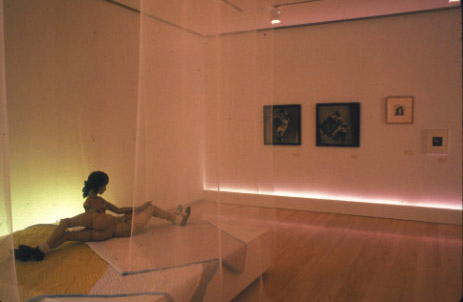|
|||||||||||||
Behind Closed Doors: The Art of Hans Bellmer
In every section and room of this exhibition, Bellmer’s
photographs of both the first and second doll (completed in 1935)
were prominently installed, even in the gallery concerning early
“pre-doll” context. Lichtenstein and Putman wanted to
be certain that the viewer would always have Bellmer’s main
works in mind when considering the mediating influences. Bellmer
produced at least thirty photographs of the first doll, and one
hundred of the second doll, each time changing the pose, states
of dress or undress, hair, accoutrements, and settings, which included
domestic interiors and outdoor scenes. The paint color chosen for
this first section was a sensual, fleshy peach. Combined with the
dolls, the erotica, and the lighting softened by colored gels, it
created the feeling of being in a boudoir, both lovely and somewhat
forbidden (illustration 2). Throughout the exhibition, the lighting--
in combinations of pink, yellow, and orange-- picked up the colors
of the hand-tinting that Bellmer often used on the doll photographs.
The gentleness of the green and pink pastel tints seemed to mock
the violent positions into which he would twist the dolls, and Putman,
along with her lighting designer, Hervé Descottes, wanted
to achieve a similar ambiguity in the installation.
The second section, “Bellmer in Nazi Germany,”
the crux of Lichtenstein’s thesis, was the most minimal in
design of the three. In this room the content was allowed to speak
more directly for itself. The paint was left a stark white, although
the same lighting scheme was used, this time either illuminating
the works from below, or by installing lighting directly into the
walls of the main entrance of the gallery (illustration 3), which
maintained the sense of being in an alternate realm. Here, the viewer
initially confronted numerous images of the first papier-mâché
doll in poses varying from prostrate and vulnerable, to coy, with
over-the-shoulder glances. Two vitrines, shorter and less dominating
than the aforementioned erotica-filled cases, contained the kind
of Nazi propaganda to which Bellmer would have been constantly subjected
after Hitler took power in 1933. This propaganda included a 1935
edition of the journal Das Deutsche Lichtbild (German Photography),
with photographs of healthy, tanned, Aryan youths, catalogues from
the Great German Art Exhibitions of 1936, 1937, and 1938, Nazi-sponsored
shows of sanctioned artwork, often highlighting Hitler’s favorite
sculptor of classical Greek rip-offs, Arno Brecker, and an original
brochure from the 1937 Degenerate Art Exhibition in Munich in which
the Nazis tried to lay out a cohesive argument that any art relying
on primitivism, expressionism, or pure abstraction was corrosive
to a healthy society. This led Bellmer to declare that he would
no longer make commercial work that contributed in any way to the
economy of the fascist state and to retreat into the studio to create
a body of work that stood in stark contrast to the Nazi program.
His production was a self-proclaimed “remedy, the compensation
for a certain impossibility of living.”3
Examples of how Bellmer’s reaction to this
repressive environment leaked into his work were immediately accessible
to the viewer through the photographs of the second doll that were
placed on walls adjacent to the Nazi-era vitrines (illustration
4). The construction of this doll was more complex than the first
in that the center ball joint Bellmer had fashioned with his brother
Fritz could have numerous appendages attached to it. He often photographed
the doll with multiple legs, and in one piece he hand-tinted angry
red spots on the legs, making them look inflamed with disease, and
thus providing a foil to the sculpted bodies sprinting through the
Nazi magazine pages nearby. Directly behind the vitrines was a disturbing
image of the doll propped against a tree in the woods, with the
shadowy figure of a voyeur standing behind the tree. In a perfect
blend of social and private, the figure functions as a stand-in
for Bellmer and the fantasies he could act out on his dolls,4
but concomitantly for the watchful and repressive regime within
which he created work that would be damned as degenerate if discovered.5 An element which allowed Putman to dramatically
foreground her design in this section was the crown jewel of the
installation, the actual second doll (La Poupée, dated 1932-45
due to elements of the first doll being incorporated into the second)
which was lent by the Centre Georges Pompidou in France. The work
was located in an intimate room just beyond the gallery with the
Nazi printed material and placed on a platform made to look like
a bed, with two blankets thrown over it on which the doll and her
double pair of legs rested (illustration 5). Putman insisted that
the blankets be the kind used for packing and shipping artwork,
for two reasons: Bellmer used the same type of padded, stitched
blankets as a backdrop for one of his strangest doll photographs,
one with the ball joint and a leg, a bow and blond hair, but no
head, and a long string with a detached eye (see illustration 37
in Lichtenstein); also, the colors one often finds in these blankets
are, like the dolls themselves, a weird mix of sweet and ugly, like
“piss yellow and sucked-lollipop pink.”6 The
platform was shrouded behind a scrim, and the translucency of this
material combined with theatrical lighting installed along the bottom
of the floor indulged the spectators in voyeuristic pleasures, inviting
them to peek into a forbidden zone in order to get to the core element
of the exhibition. Putman used a similar setting (without the packing
blankets) to display La Poupée in the 1998 Guggenheim exhibition
Guggenheim/Pompidou: A Rendezvous.
After encountering the grandiosity of La Poupée,
the viewer then moved into the third and final section, “Bellmer
and Surrealism.” Aspects of this section reflected those of
the first: pastel hues, this time in light green, and tall vitrines,
although the second time around the disconcertingly “pretty”
color and huge vitrines were not as jarring to the eye. The cases
contained Surrealist books and journals that bore Bellmer’s
influence7 spilling out of the boxes and drawers. Breton
and Paul Eluard, the leading poets of the Surrealist movement, were
introduced to Bellmer’s work by his adored cousin Ursula when
she went to Paris to study at the Sorbonne. She brought eighteen
photographs of Bellmer’s first doll to Breton and Eluard, who
so admired them that they were published the same year in Minotaure.
The two poets understood that Bellmer’s project was an attempt
to explore the same subversive, sexual realm that they tried to
use in their work as an alternative to the dictates of bourgeois
existence. Since Freud’s sexually-based readings of the subconscious
became a powerful weapon for the Surrealists in this battle against
the bourgeoisie, the boxes, drawers, and valises that contained
the Surrealist journals carried as much metaphorical weight in this
section as in the earlier section with the erotica. Bellmer finally
left Germany in 1938 after his wife’s death, and came to Paris
to join up with these kindred spirits. In the 1940s he began collaborating
with the renegade Surrealist, Georges Bataille, on his book Story
of the Eye. Original dry-point engravings of the illustrations for
the book were installed in wall vitrines toward the end of the exhibition.
Bellmer lived in France for the rest of his life, and the section
on Surrealism thus appropriately functioned as the conclusion to
the retrospective. |
|||||||||||||
